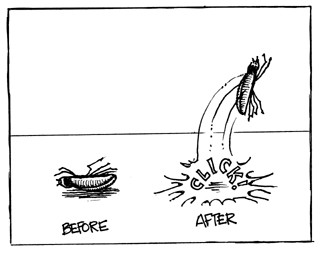ClickBeetleMania
Tales of a Clicker Picker Upper
By Wayne Alan Brenner, Fri., Sept. 8, 2000

It's click beetle season here in the great state of Texas, and the creepy little buggers are everywhere: scrabbling around, dashing themselves at light bulbs, performing their brittle terpsichore upon the floors and counters of our houses whenever they can sneak inside.
"Click Beetle" is the common name for any adult beetle of the family Elateridae. So called, Latinly and commonly, because these thin brown creatures "elate" themselves. They don't elate themselves -- as might a human indulging in a few hits of X at some overpriced thumpa-thumpa dance club downtown -- emotionally, of course; they do it in a purely physical manner. If a click beetle's fallen over, it simply bends its chitinous head and prothorax, creating a kind of kink in its flexible spinal process, then instantly straightens them all and click! Into the air goes our unique coleopteroid -- sometimes as high as six inches!
The larval stage of this beetle is what folks who have reason to call them anything call "wireworms." They're pests that specialize in destroying the root systems of plants, these larvae, and agriculture professionals abhor them with a passion normally reserved for the swimsuit issue of The Old Farmer's Almanac. The adult beetles, though, pose little if any threat to crops -- other than the potential for their antics to distract bored field laborers.
One of the largest of this insect tribe is known as an "Eyed Elater" because it has two white spots -- eyes, see? -- on its thorax. I was delighted to find one of these guys near the mailbox a few weeks ago, the first one of that particular species I'd ever seen outside a book; and I'd be exaggerating if I said I went inside and marked the date on my calendar, yes; but I've marked it in my heart. And I'm only slightly less pleased that the eyed one's less fancy cousins are currently all over the place. They're on the front porch, they're crawling through the lawn, they're creeping into the house and flying into my left eye when I'm trying to get into bed without waking up my wife.
It's a bit difficult to not wake up one's wife, FYI, when one is reacting uncalmly to the sudden and violent intrusion of some then-unknown insect into one's optic flesh; and one's wife, suddenly awake, may even suspect that one is having a terrible (and terribly loud) seizure.

Maybe it's due to situations like the above-mentioned that there are few things I find more amusing than playing with a click beetle -- flipping one over, waiting for the click, and watching it snap briskly into the air. It's a joy infused with both scientific curiosity and the more gleeful sadisms of childhood. And if one of the cats can be coaxed into participating -- and it's really not too hard to convince a cat of this -- so much the better. Then it's even more fun than getting really stoned and watching The Hellstrom Chronicles.
But I didn't play this cruel game with the Eyed Elater. He was, for me, a rare find, so I treated him with a bit more respect, simply scrutinized him for a few minutes, then set him onto the branch of a nearby tree. But it got me to thinking, as I sometimes do, about how incredibly cool it would be to discover a new species of insect. One that nobody's ever heard of before, one that nobody even suspects would exist. Or, okay, even one just slightly removed from its nearest kin would do. Hell, even the most meager variation on the old click beetle theme, even that would suffice. Because they'd name the damned thing after me, anyway, wouldn't they?
Alaus Brenneri ... ah, the ego-stroking sound of it!
But, in lieu of that, since the likelihood of my discovering such a thing can be neatly summed up with references to snowballs and the most popular of Dante's big schticks ... in lieu of that, and for your entomological amusement, I'm glad to offer a few potential variations on the common elater:
1. The Point-&-Click Beetle This one's fond of technology and thrives, in the larval stage, on silicon and plastic. The largest of the elaters, as an adult its outer chitin is capable of high-speed color change; this, in conjunction with its uniquely single antenna, allows the Point-&-Click to passably mimic several styles of computer mouse. When some geek tells you your expensive new system's got bugs? This is what they're talking about.
2. The Click-&-Clack Beetle These beetles, which invariably travel in pairs, are useful in automotive maintenance and repair. When annoyed -- which each one is, almost constantly, by the other -- they secrete an oil unsurpassed for lubricating the frictioned parts of an internal combustion engine. These insects are rather geographically restricted, however, seldom straying beyond their natural northeastern territory.
3. The Clique Beetle These beetles are harmless when alone, but in greater numbers they are known to become dangerous: to other beetle species, to birds, to humans, to anything that's not exactly like they are. One subspecies, the so-called Black Trenchcoat Beetle, is thought to be deadly under certain conditions; verification of this theory awaits further field testing.
4. The Kleig Beetle The result of genetic engineering by a Swedish pharmaceutical consortium, this species, crossbred with fireflies in order to incorporate the latter's bioluminescence, is capable of emitting fierce bursts of light -- over 1,000 lumens for one-tenth of a second -- with which to stun potential assailants. Also known as Paparazzi Bug.
5. The Klink Beetle Barely distinguishable from similar species, save for a series of minute striations on the underside of the prothorax, this variation is chiefly known for having been discovered by professional opera singer and entomological hobbyist Werner Klemperer. ![]()








